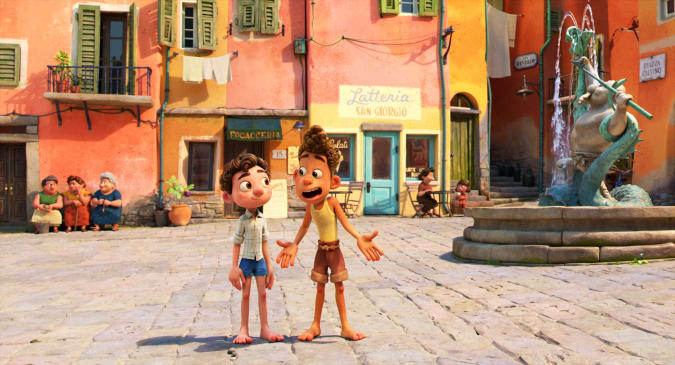The following contains spoilers for the first act of “Luca”.
During its first decade of making feature films, there was a saying that Pixar chose its projects around things they wanted to try to animate. The life of an insect star plants, Monsters Inc. had a lot of fur, The world of Nemo was placed under water. Even later productions were about the refinement of techniques and textures, such as hair and clothing in Courageous. After 16 years, Pixar really doesn’t have anything left to prove, which means the studio can finally settle into a house style.
Released this week on Disney +, Luca is the story of a young sea monster who becomes curious about the surface world. If you think it looks like The little Mermaid, well, yeah, that’s really Pixar’s take on this fable. Luca stumbles upon human artifacts and ends up venturing above the surface, discovering that when he leaves his watery environment, he transforms into a human. This is where the similarities to the Disney film end, as Luca meets another sea dweller in love with the world who breathes the air, and the two travel to a nearby town in search of a Vespa scooter. It’s a pretty blatant product placement, but also charming, given the importance of the brand in our ideas about Italian culture, especially mid-20th century films like roman holidays. If this film is romantic, it is about what the iconic brand stands for: freedom.
The film is also reminiscent of Hideo Miyazaki’s Ponyo, which is good, because that’s what Luca feels. It’s an American-made Ghibli film, where the object is acceptance, platonic love, and a deep appreciation for simple pleasures like a plate full of pasta. Which Luca has a lot of (it’s part of the central plot) and it’s absolutely tantalizing. Luca is a showcase of all the skills Pixar has mastered in its four decades of existence. There is life-like food, hair, tissue, and plenty of water, both in the form of ocean and rain.
Disney / pixar
The only thing that still retains a cartoonish quality are the people. It’s more of an aesthetic choice at this point, rather than a sign of limited character models, like those that populated the company’s early feature films like Toy story and Monsters Inc. The characters are all soft with rounded edges, painted in more dreamy and muted colors than bright. Pixar has been developing a prototypical character model since Ratatouille, the one that has been repeated over the past decade in movies like last year’s Forward and Soul. But they were fantastic movies with shiny, weird sets – even Soul divides his time between New York and the beyond. Humans have much more screen time in Lucaeven though it is a fantastic film.
Luca is a showcase for all the skills Pixar has mastered in its four decades of existence.
Although the protagonists are sea monsters, the underwater scenes are actually quite mundane: Luca’s family lives in a cave, and the child spends his days watching out for a school of sheep-like fish. It’s grounded in a way that most Pixar movies aren’t; his closest relative in the Pixar stable is Ratatouille, and not just because both take place in a cartoonish European country.

Disney / pixar
Pixar has always had a knack for history and that in Luca is quite touching, but now that the studio has honed its craft, the graphics can live up to the narrative, visualizing those emotions with depths of color and texture that movies love. Toy story could only dream. Pixar’s house style is no longer limited by technology, finally allowing movies to look how they feel.
All products recommended by Engadget are selected by our editorial team, independent of our parent company. Some of our stories include affiliate links. If you buy something through any of these links, we may earn an affiliate commission.
